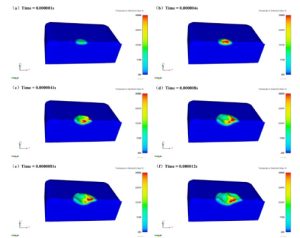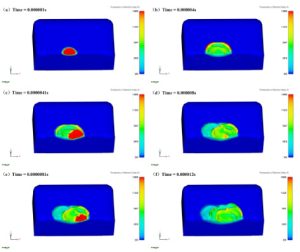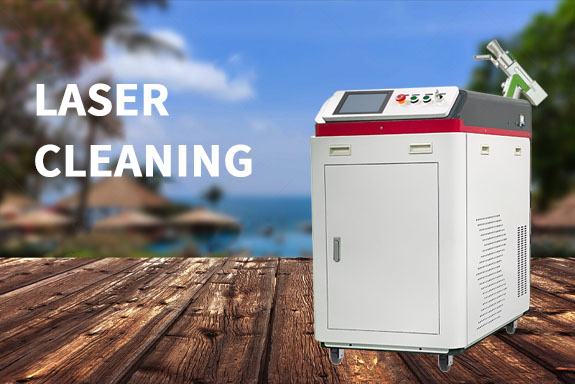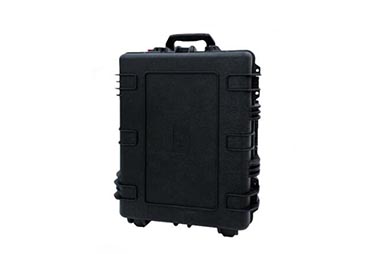For decades, laser cleaning has gradually matured and found applications in various fields due to its advantages such as non-contact, low damage, and environmentally friendly properties. Currently, the mainstream cleaning equipment on the market is divided into pulsed laser cleaning machines and continuous laser cleaning machines. The pulsed laser cleaning provides a high surface cleanliness but has lower efficiency, while the continuous laser cleaning is more efficient but results in lower surface cleanliness. Therefore, an important area of current research is how to effectively combine the advantages of these two types of lasers to maximize the benefits of laser cleaning technology.
Analysis of Mechanisms of Continuous and Pulsed Laser Interaction

Composite Laser Cleaning Technology and Applications

The temperature distribution contour map of pulsed laser rust removal.
Research on numerical simulations of the rust removal process with continuous and pulsed laser shows that the continuous laser source causes the rust layer surface temperature to exceed 30,000 K, with the substrate surface temperature reaching nearly 3500 K. The pulsed laser source raises the rust layer surface temperature to a maximum of 14,758 K, while the substrate surface temperature reaches 2255 K. Comparative analysis reveals that continuous laser sources have a stronger thermal effect, resulting in higher surface temperatures during the rust removal process, which increases the likelihood of thermal damage to the substrate. In contrast, pulsed lasers have a higher peak power, greater heating efficiency, and faster temperature change rates, but the duration of the pulses is short, with the cumulative effect of multiple laser pulses causing the temperature to increase rapidly in a series of steps. Both types of lasers can cause substrate melting, with the continuous laser leaving a deep, uniform groove, and the pulsed laser leaving a pattern of overlapping crater-like spots with progressively deeper pits. Based on the cleaning mechanisms of individual lasers, we next conducted tests to compare single-laser and composite cleaning effects.
Comparison of Continuous, Nanosecond Pulsed Single-Laser and Composite Cleaning Effects
To highlight the advantages of composite laser cleaning technology over single-laser cleaning, we performed cleaning tests on the oxide scale of carbon steel welds. The tests utilized 500W pulsed equipment, 2000W continuous laser equipment, and a combination of 500W pulsed laser with a 2000W continuous laser. The test results are as follows:


From the three experimental groups, the composite laser cleaning technology using 500W pulsed and 2000W continuous lasers achieved the best cleaning effect and efficiency for the oxide scale on carbon steel welds.
Based on extensive practical applications and technical accumulation, we coupled the output of continuous and nanosecond pulsed lasers in the optical path and designed a highly competitive composite laser cleaning machine. This equipment integrates the high efficiency of continuous lasers with the high cleanliness of pulsed lasers, overcoming the shortcomings of single-laser cleaning and offering advantages such as improved cleaning quality, increased efficiency, and stable cleaning processing.

- Continuous and pulsed lasers can be output as needed, efficiently and thoroughly cleaning post-weld oxides (metal oxides, oxide layers, rust, etc.);
- The main machine uses cabinet air conditioning cooling + internal water circulation, with a dust-sealed cleaning head for long-term stable operation;
- Equipped with communication interfaces, it is easy to integrate with welding equipment.
Application Case: Pipeline Weld Rust Removal

Using composite laser cleaning, the cleaned surface not only meets the metal surface cleaning grade of Sa2, but the cleaning efficiency also meets customer requirements, greatly improving the working environment for operators. The composite laser cleaning machine inherits the high cleanliness of pulsed laser cleaning and the high efficiency of continuous laser cleaning, addressing customer needs for both high efficiency and high cleanliness. This equipment is expected to become a new growth point in the laser cleaning industry.
由用户投稿整理稿件发布,不代表本站观点及观点,进行交流学习之用,如涉及版权等问题,请随时联系我们(yangmei@bjjcz.com),我们将在第一时间给予处理。







